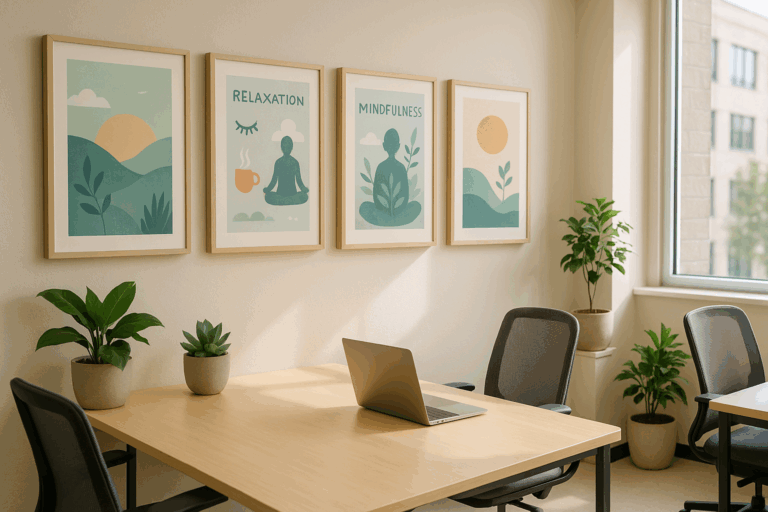An ideal place to begin? Right at the heart of your organization – your office. Establishing a mental health library can have a significant impact on employees’ well-being. An office that demonstrates care for its workers’ mental health is one that fosters a healthy and productive work environment. If you’re considering this initiative, you’ve landed on the right page. This comprehensive guide will not only outline why creating a mental health library is crucial but also provide actionable tips on how to start and maintain this essential resource.
Let’s delve into the crux of the matter. Mental health problems are not uncommon in the workplace. From stress-induced burnout to anxiety disorders, these issues, if unaddressed, can lead to decreased productivity and low morale among employees. However, the stigma associated with mental health can often prevent individuals from seeking help. Therefore, it’s not just about providing resources – it’s about creating an environment that supports their usage. 🌱
Here’s where a mental health library comes in. This one-stop resource center, packed with books, articles, videos, and other materials, can serve as an invaluable tool for employees. It can help educate and raise awareness about mental health, de-stigmatize mental health issues, and provide practical tips for managing stress and other work-related problems. Sounds like a worthwhile investment, doesn’t it? 😊
However, creating and maintaining a mental health library is not a walk in the park. It requires careful planning, strategic execution, and ongoing effort to keep it resourceful and relevant. But fear not, the subsequent sections of this article will equip you with all the knowledge you need to build and sustain a successful mental health library. We’ll cover topics such as identifying the right resources, promoting your library, and assessing its impact on employee well-being.
Perhaps you’re questioning, “Why should I go through all this trouble?” Well, investing in your employees’ mental health can have numerous benefits. A mentally healthy workforce is more likely to be engaged, productive, and loyal to the organization. It can lead to fewer absences, lower turnover rates, and improved overall performance. Plus, it sends a strong message to your employees that their well-being matters to the company.💡
Let’s get started on this journey towards fostering a healthier work environment. By the end of this article, you will have a comprehensive understanding of why a mental health library is an asset to your office and how you can effectively create and maintain one. Remember, promoting mental health in the workplace is not a luxury – it’s a necessity. Let’s make it a priority today!
📚 Kickstart Your Mental Health Library: The Why and How
The current climate of the business world has shifted drastically towards employee well-being. With an increased understanding of mental health’s impact on productivity and work satisfaction, more companies are investing in resources that support their employees’ mental health. One effective way of doing this is by creating a mental health library in your office. This article will provide tips for starting and maintaining a resourceful collection.
Before we dive into the details, let’s understand why having a mental health library is essential. With the ongoing pandemic, there has been a significant increase in stress and anxiety amongst employees worldwide. A recent report by the World Health Organization states that one in four people in the world will be affected by mental or neurological disorders at some point in their lives, further emphasizing the need for mental health resources in the workplace.
Having a mental health library in your office can act as a hub for all such resources, offering comfort, education, and support to employees. Besides, it can be an empowering initiative that can normalize conversations about mental health and break down the associated stigmas. Let’s explore how to create such a library.
🧰 Setting Up Your Mental Health Library: Step by Step Guide
Setting up a mental health library might seem overwhelming, but with the right approach, it can be a smooth process. Here is a step-by-step guide to help you through it.
Identifying the Needs
The first step in creating a mental health library is identifying what your employees need. Conducting a needs assessment survey can help with this. The survey can include questions about stress levels, work-life balance, and what kind of resources employees would find helpful. This data will provide a foundation for your library.
Curating the Resources
Once you have identified the needs, the next step is to curate relevant resources. This can include books, articles, webinars, podcasts, and videos. Ensure that these resources are evidence-based and from reputable sources. Check out this video “How to choose the best mental health resources for your library” by Psychology Today for some tips.
Organizing the Library
The last step is organizing the library. You can categorize the resources based on topics like stress management, depression, anxiety, etc. Using labels and signs can make the library user-friendly.
🚀 Maintaining Your Mental Health Library: Tips for Success
Maintaining a mental health library is as crucial as setting it up. Here are some tips to ensure the library stays relevant and useful.
Regularly Update the Resources
Mental health research is a continuously evolving field. Therefore, it’s essential to keep your library updated with the latest findings and resources. Subscribing to mental health journals or newsletters can be a good way to stay informed.
Engage Employees
Engaging employees is key to the success of your mental health library. Encourage them to use the library and provide feedback on the resources. This feedback can be instrumental in improving the library. You can also conduct regular workshops or sessions to promote the usage of the library.
Measure the Impact
Lastly, measure the impact of your mental health library. This can be done through surveys or feedback sessions. The results will help you understand what’s working and what needs improvement.
🔎 Comparative Analysis: Digital vs. Physical Mental Health Library
When setting up a mental health library, one decision you’ll need to make is whether to go digital or physical. Both have their pros and cons, as illustrated in the table below:
| Digital Library | Physical Library | |
|---|---|---|
| Accessibility | Available anytime, anywhere. | Limited to office hours and location. |
| Cost | Can be cheaper as it eliminates the need for physical space and materials. | Can be expensive due to the need for physical space and materials. |
| Interaction | Limited interaction as resources are accessed individually. | Can encourage group discussions and interactions. |
Ultimately, the decision will depend on your company’s needs and resources. Whichever route you choose, remember the ultimate goal is to provide support and resources for your employees’ mental health.
💡 Final Thoughts
Creating a mental health library in your office is a significant step towards promoting employee well-being. While it requires time and effort, the potential benefits for your employees’ mental health make it a worthwhile investment. So why wait? Start creating your mental health library today!

Conclusion
In conclusion, we’ve taken a comprehensive journey, exploring intricate and often complex concepts within the fields of IT and Engineering. Our understanding of these subjects is pivotal in our tech-driven world, and we hope that this exploration has enriched your knowledge and piqued your interest in these areas. Let’s recap the key points we’ve touched upon.
We delved deep into the intricacies of software engineering, highlighting its essential role in modern-day life. From the creation of user-friendly interfaces to the development of secure and efficient systems, the impact of software engineering is far-reaching and vital. This significance was echoed in our exploration of concepts such as version control, software testing, and object-oriented programming. 💻
The world of IT was another sphere we navigated through, discussing the indispensable role of data management and network security. The importance of understanding the ways to protect sensitive information cannot be understated in today’s digital landscape, and we trust that our discussions around encryption, firewalls, and two-factor authentication offered valuable insights. 🖧
We also emphasized the rapidly evolving nature of both fields. As technology advances, so does the demand for professionals who are not only knowledgeable but also adaptable to these changes. This brings us to the importance of continual learning and staying updated, a theme we’ve reiterated throughout our discussions. 📘
To further your understanding, we suggest taking advantage of resources like IEEE and ACM. These platforms offer a wealth of information that can keep you informed about the latest developments in IT and engineering.
As we wrap up, we’d like to encourage you to take the concepts we’ve discussed and put them into action. Whether you are a budding software engineer, a seasoned IT professional, or someone curious about these subjects, your contribution can make a difference. Let’s foster a culture of knowledge sharing, innovation, and continual learning. 🚀
We’d love to hear your thoughts on this article. Feel free to leave a comment below or share this piece with others who might find it useful. Your feedback is invaluable to us, helping us to refine our content and ensure we’re providing the information that matters most to you.
Thank you for accompanying us on this journey. We look forward to exploring more fascinating topics with you in the future. Stay curious, keep learning, and let’s continue to unravel the complexities of our technological world together. 🌐
References:
IEEE
ACM



